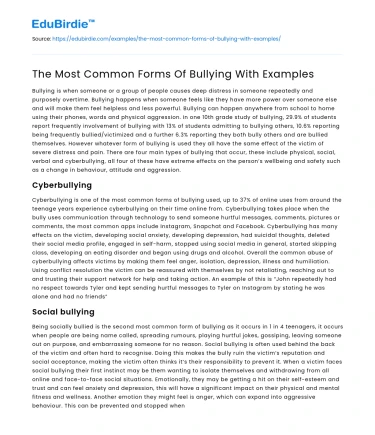Bullying is when someone or a group of people causes deep distress in someone repeatedly and purposely overtime. Bullying happens when someone feels like they have more power over someone else and will make them feel helpless and less powerful. Bullying can happen anywhere from school to home using their phones, words and physical aggression. In one 10th grade study of bullying, 29.9% of students report frequently involvement of bullying with 13% of students admitting to bullying others, 10.6% reporting being frequently bullied/victimized and a further 6.3% reporting they both bully others and are bullied themselves. However whatever form of bullying is used they all have the same effect of the victim of severe distress and pain. There are four main types of bullying that occur, these include physical, social, verbal and cyberbullying, all four of these have extreme effects on the person’s wellbeing and safety such as a change in behaviour, attitude and aggression.
Cyberbullying
Cyberbullying is one of the most common forms of bullying used, up to 37% of online uses from around the teenage years experience cyberbullying on their time online from. Cyberbullying takes place when the bully uses communication through technology to send someone hurtful messages, comments, pictures or comments, the most common apps include Instagram, Snapchat and Facebook. Cyberbullying has many effects on the victim, developing social anxiety, developing depression, had suicidal thoughts, deleted their social media profile, engaged in self-harm, stopped using social media in general, started skipping class, developing an eating disorder and began using drugs and alcohol. Overall the common abuse of cyberbullying affects victims by making them feel anger, isolation, depression, illness and humiliation. Using conflict resolution the victim can be reassured with themselves by not retaliating, reaching out to and trusting their support network for help and taking action. An example of this is “John repeatedly had no respect towards Tyler and kept sending hurtful messages to Tyler on Instagram by stating he was alone and had no friends”
Save your time!
We can take care of your essay
- Proper editing and formatting
- Free revision, title page, and bibliography
- Flexible prices and money-back guarantee
Social bullying
Being socially bullied is the second most common form of bullying as it occurs in 1 in 4 teenagers, it occurs when people are being name called, spreading rumours, playing hurtful jokes, gossiping, leaving someone out on purpose, and embarrassing someone for no reason. Social bullying is often used behind the back of the victim and often hard to recognise. Doing this makes the bully ruin the victim’s reputation and social acceptance, making the victim often thinks it’s their responsibility to prevent it. When a victim faces social bullying their first instinct may be them wanting to isolate themselves and withdrawing from all online and face-to-face social situations. Emotionally, they may be getting a hit on their self-esteem and trust and can feel anxiety and depression, this will have a significant impact on their physical and mental fitness and wellness. Another emotion they might feel is anger, which can expand into aggressive behaviour. This can be prevented and stopped when the victim finds new friends and avoids toxic people. An example of this is “Perry was giving indirect communication directed at Matilda she was eye-rolling and laughing at the rumours, however, Matilda was able to ignore them and focus on her real friends when feeling challenged.”
Physical Bullying
Physical abuse is a consequential problem as it affects not only the victim and the bully but also the witnesses. Physical bullying happens when the bully has no empathy to the victim and uses their body to create hands-on violence such as poking, hitting, punching, kicking, spitting, tripping or pushing someone, breaking someone’s things, pulling faces or making rude hand signals. Physical bullying can be relatively easy to recognise some symptoms and signs are coming home with bruises, cuttings and other unexplained injuries, getting broken clothing, books, or belongings, frequently 'losing' items they carry to school, not feeling good before school or school events, avoiding other lessons, trying to stop going to school or heading to school in a certain manner, such as taking odd routes home from school or not trying to ride a bus, behaving unhappy or upset and separating from others. Like all bullying, this has an impact on the victim by making them develop mental health issues such as suicide as well as physical injuries. An example of this is “Jessy couldn’t resist the temptation of bashing up Jacob who was sitting on the seat not bothering anyone, he approached him and whipped his fist as Jacobs’s head laughing and humiliating him”
Verbal Bullying
Verbal bullying is when an individual is name called, teased, puts down, threatened to cause harm themselves and being mocked. The concept of verbal bullying is when a person utilizes offensive language to exert control over his or her peers, trying to gain deeper power. Although at first the consequences of verbal bullying can become more subtle, it operates over lengthy stretches of time to undermine the self-image and self-esteem of a kid. This can result in depression, anxiety, and other issues. In severe instances, many well-known incidents of adolescent suicide were related to a classmate or peer's excessive verbal abuse. This can be shown in an example when “ Katy, known as the popular girl thinks that she has the right to bully Linda and treat her unequally because she goes into the library every lunch to read, Katy repetitively calls Linda a nerd and makes up offensive jokes. Katy always threatens her with the affirmation of her friends by saying if she comes near her she will spread rumours”.






 Stuck on your essay?
Stuck on your essay?

